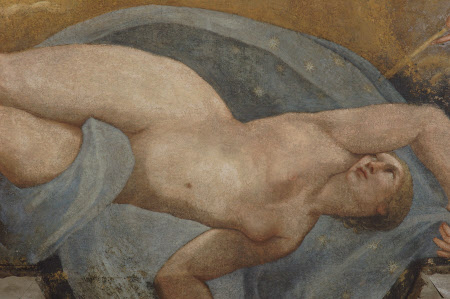The Separation of Night from Day
Guido Reni (Bologna 1575 – Bologna 1642)
Category
Art / Oil paintings
Date
1598 - 1599 - circa 1600
Materials
Fresco transferred to canvas
Measurements
4267 mm (168 in) (Diam)
Place of origin
Bologna
Order this imageCollection
Kingston Lacy Estate, Dorset
NT 1257254
Caption
The separation of night from day happens in the biblical story of the Creation. A figure, a winged celestial being or spirit, who has variously been called Dawn or Twilight, separates two figures with two wands. Day, a scantily clad young man moves swiftly towards the light, holding aloft a flaming red cloak looking back over his shoulder in the direction of Night from whom he has just withdrawn. Night, in turn, partially enveloped in clouds, raises her star-studded mantle as if to cover her nakedness and gazes in the direction of retreating Day. This was a painted fresco in oils, one of very few by Reni in that medium, and one of his earliest works. It was originally on a curved ceiling in the Palazzo Zani, in Bologna, but was taken down, using a novel technique, strappo (detaching the paint-infused plaster from the plaster behind, and reapplying it to canvas) and bought by William John Bankes (1786–1855) in 1840. It was restored and installed in the Library at Kingston Lacy in 2006 whereas the Fall of Phaethon is still in the palace.
Summary
Fresco transferred to canvas, The Separation of Night from Day, by Guido Reni (Bologna 1575 – Bologna 1642), 1598-99/1600. Above a female winged figure dressed in green holds a pair of golden dividers and crossing them across two figures.The male figure on the left with swirling red drapery and against a sunny golden background represents Day whilst the female figure beginning to cover herself with swirling transparent drapery studded with stars, against a dark background, on the right, depicts Night. This detached fresco is one of the earliest works by Reni, and one of very few by him in that medium. It was originally on a curved ceiling in the main saloon in Palazzo Zani, 56 via Santo Stefano, in Bologna, but was taken down, using a novel technique, strappo (detaching the paint-infused plaster from the plaster behind, and reapplying it to canvas). Restored by Bush and Berry and re-installed in the Library in 2006.
Provenance
Commissioned from the young artist in 1599 and painted (with the Fall of Phaethon) on a ceiling in the Palazzo Zani, Via Santo Stefano 56, Bologna (built 1564-94); detached in 1840 and sold soon after to the then exiled (September 1841) William John Bankes (1786-1855); bequeathed by (Henry John) Ralph Bankes (1902 – 1981) to the National Trust, together with the estates of Corfe Castle and Kingston Lacy and its entire contents in 1981
Credit line
Kingston Lacy, The Bankes Collection (National Trust)
Makers and roles
Guido Reni (Bologna 1575 – Bologna 1642), artist
References
Waagen 1857 Gustav Waagen, Galleries and Cabinets of Art in Great Britain, London, 1857, p. 379 Pepper 1969 D.Stephen Pepper, “Guido Reni’s Early Style: His Activity in Bologna, 1595-1601”, Burlington Magazine, 111, 1969, p.472 ff Pepper 1984 D. Stephen Pepper, Guido Reni: A Complete Catalogue of his Works with an Introductory Text, Oxford 1984, pp.211-212, no.9, pl.9 Cordelier 1987 Daemonic Cordelier, “Guido Reni’s ‘Separation of Day and Night’”, Burlington Magazine, Vol.CXXIX, no.1007, February 1987, pp.81-82, illus fig.16 Johnston 1993 Catherine Johnston, “A Visual Source for an Early Fresco by Guido Reni and Speculations on its Meaning” Nationalmuseum Bulletin XVII/2, Stockholm, 1993, pp.11-20 Sitwell, Bush & Berry 2006 'From Cosmopolitan Italy to Rural Dorset: The Separation of Night from Day by Guido Reni, 1599' for The Object in Context: Crossing Conservation Boundaries: Contributions to the Munich Congress 28 August – 1 September 2006






